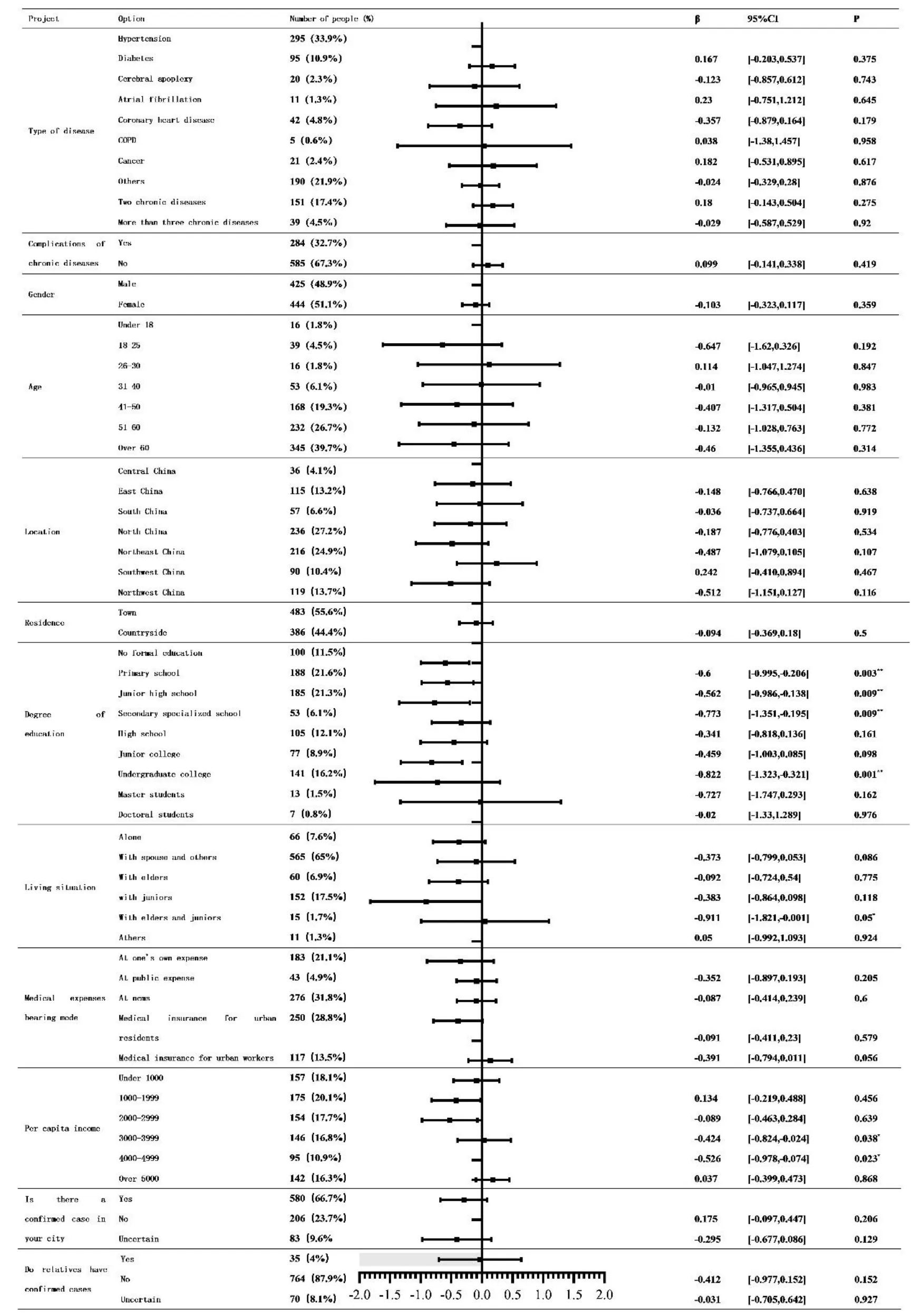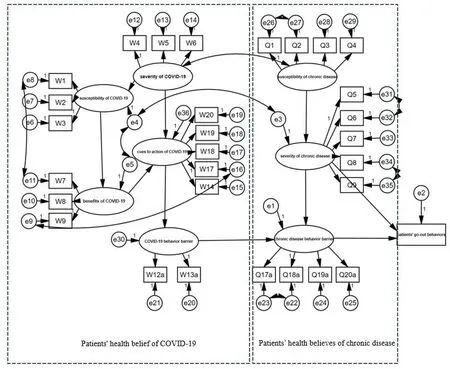Going-out Behaviors of Patients with Chronic Diseases When Purchasing Drugs During Covid-19
2021-10-20SiTongLiuShuXianXuHaiPingXuLinLingShiZheFengLiuXiaoLinXuYiBoWu
Si-Tong Liu,Shu-Xian Xu,Hai-Ping Xu,Lin-Ling Shi,Zhe-Feng Liu,Xiao-Lin Xu,Yi-Bo Wu
1Department of Pharmacy Administration and Clinical Pharmacy School of Pharmaceutical Sciences,Peking University,Beijing 100191,China.2Evidence-based Communication and Information Management Research Center,Liaoning Technical University College of the Media and Arts,Fuxin 123000,China.3School of pharmacy,Shenyang Pharmaceutical University,Benxi 117004,China.4School of Pharmaceutical Sciences,Shandong University,Shandong 250012,China.5Party Committee Propaganda Department of Affiliated Hospital of Nantong University,Nantong 226019,China.6Xiangya School of Public Health of Central South University,Changsha 410000,China.7Department of Pharmacy,Beijing Children’s Hospital,Capital Medical University,Beijing 100145,China.8School of Public Health,Peking University,Beijing 100191,China;9.Key Research Base of Philosophy and Social Sciences in Shanxi Province,Health Culture Research Center of Shanxi,Xi'an 712046,China).
Abstract Objective:This study sheds light on the going-out behaviors of patients with chronic diseases when purchasing drugs during COVID-19,explores what factors influence these behaviors,and makes recommendations to guarantee the pharmaceutical treatment of patients with chronic diseases.Methods:A questionnaire based on the health belief model (HBM) was designed and convenience sampling was employed to administer the online questionnaires.The influence of the respondents’demographic information on their going-out behaviors was analyzed by means of multiple linear regression.A structural equation model(SEM)was constructed to explore how health beliefs related to chronic diseases and COVID-19 influenced patients’going-out behaviors.Results:A total of 869 questionnaires were analyzed.The structural equation model revealed that while the severity of the chronic disease had a direct positive effect on going-out behaviors(λ=0.106),chronic disease behavior barriers had a direct negative effect on their going-out behaviors(λ=-0.204).Conclusion:Educational background,co-living situation,and income could influence patients’ going-out behaviors.The severity of the chronic disease and chronic disease behavior barriers directly affected patients’going-out behaviors.Furthermore,patients’ health beliefs about COVID-19 ultimately affected their going-out behaviors by influencing their health beliefs related to chronic disease.
Keywords:COVID-19,Chronic disease,Going-out behaviors,Influencing factors
Introduction
The novel coronavirus pneumonia (COVID-19),which was first detected in China at the end of 2019,caused a global pandemic.By May 10,2021,COVID-19 had infected more than 158 million individuals and caused over three million deaths throughout the world.With a long incubation period and various transmission routes,COVID-19 is potentially a long-term health public health concern,although the Chinese population gradually resumed work and school.The Lancet noted that 50% of patients who were first diagnosed with COVID-19 in Jinyintan Hospital in Wuhan,China,suffered chronic conditions such as cardiovascular disease and diabetes [1].A study reported in JAMA confirmed that patients with chronic diseases are more susceptible to COVID-19 [2].To reduce the risk of infection,it is critical that patients with chronic diseases take personal protective measures and limit their outdoor time during the pandemic.However,the patients’ need for regular medication on a long-term basis has clashed with the inconvenience of buying drugs during the pandemic.It was thought that the inconvenience associated with buying medication during the pandemic could have an adverse impact on the adherence of patients to acquire medication,thus leading to the recurrence,progression,and poor prognosis of the particular disease they have.Therefore,to determine whether patients with chronic diseases left their homes to buy drugs during the pandemic and explore any influencing factors of related behaviors,a questionnaire based on the health belief model (HBM) was designed and distributed in an endeavor to provide pharmaceutical advice to patients with chronic diseases during COVID-19.
Respondents and methods
Respondents
To be included in the study,the respondents had to satisfy the following criteria:suffer from at least one chronic disease,specifically,hypertension,diabetes,cerebrovascular accident,atrial fib55rillation,coronary heart disease,COPD,cancer,and/or asthma;ability to think independently and express their views clearly;understand all the questions of the questionnaires;and volunteer to participate in the study.
The following exclusion criteria were employed:intellectual disability,hearing or vision impairments,and/or inability to think independently and express views clearly;incomplete questionnaires;and questionnaires with logical errors.
Questionnaire design
The questionnaire was based on the HBM,which posits that participants’health beliefs and behaviors are primarily related to six aspects,namely,cognition of the severity of disease,cognition of the susceptibility of disease,cognition of benefits of adopting suggestive behaviors,cognition of barriers of adopting suggestive behaviors,self-efficacy,and cues to health action [3].The questionnaire comprises three sections.Demographic information such as gender,age,location,education,and occupation is required in the first section.The second section includes questions related to the health beliefs of chronic diseases and COVID-19.Chronic diseases are assessed by 13 items,which are grouped in three dimensions:the susceptibility of chronic disease (4),the severity of chronic disease (5),and chronic disease behavior barriers (4).The severity of COVID-19 is evaluated by 16 items,which are grouped in five dimensions:the severity of COVID-19(3),the susceptibility of COVID-19 (3),the benefits of COVID-19 (3),cues to action of COVID-19 (5),and COVID-19 behavior barriers (2).The third section includes six items based on the trans-theoretical model of behavior.These items,which are rated on a 6-point scale,ranging from 1 (low) to 6 (high),include never buy drugs in the store,used to buy drugs in the store but never go at present,hesitant to buy drugs in the store,and have bought drugs in the store on a regular basis during COVID-19.
Data collection
Survey website Questionnaire star,a professional online survey software platform,was employed to collect information.Convenience sampling was used to invite respondents.Investigators were recruited nationally and trained uniformly before the questionnaires were distributed from March 4 to April 20,2020.The investigators sent a link to the respondents individually through social media platforms,including WeChat and QQ.Although the investigators were able to assist the respondents,they could not complete the questionnaires for them.
Ethical clearance
Ethical clearance was granted by the Central South University(XYGW-2020-02).
Quality control
Before distribution,the validity and reliability of the questionnaire were assessed and irrelevant items were excluded.The normality and uniformity of administering the questionnaire was guaranteed by the investigators who had been trained uniformly.The respondents completed the questionnaire anonymously.Their privacy was protected to improve the authenticity of the data.Invalid questionnaires,including those that were completed in less than one minute or had logistic errors,were excluded.
Statistical analysis
SPSS21.0 software (IBM,Armonk,NY,USA) was employed for the statistical analysis of the questionnaires.Cronbach’s α was performed to check the reliability the questionnaire. The Kaiser-Meyer-Olkin (KMO) value of the questionnaire was employed to modify the questionnaire’s items and determine whether to conduct factor analysis.Descriptive statistics was used to characterize the demographic information.Categorical variables were set as dummy variables to influence the factor analysis and the first category of each group was set as the control group.While the patients’going-out behaviors to buy drugs were set as the dependent variables,their demographic information was set as the independent variable when performing multiple linear regression analysis and exploring factors that influence their going-out behaviors to buy drugs.Pearson correlation coefficients were employed to analyze the correlation analysis of the matrix.Furthermore,IMB AMOS 24.0 was used to develop structural equation models for latent variable analysis.Some of the indices used to evaluate the rationality of structural equation models included Chi-square/DF (Chi squared over degrees of freedom),GFI (Goodness of Fit Index),AGFI(Adjusted Goodness of Fit Index),CFI (Comparative Fit Indexes),and RMSEA(Root Mean Square Error of Approximation),with a significance criterion of 0.05.
Results
The results revealed that 921 questionnaires were returned of which 869 were valid (valid return rate:94.35%).
Test for reliability of questionnaire
Cronbach’s α of the questionnaire was 0.929 (>0.9),indicating good reliability.The KMO value was 0.946 and the Bartlett spherical test was statistically significant (P<0.001),which indicated that it was suitable for factor analysis.Eight dimensions of the questionnaire emerged from the factor analysis.The modified items were consistent with the original questionnaire design and the cumulative variance was 79.008%(>50%),demonstrating excellent validity.
Analysis of demographic characteristics and influencing factors of drug-purchasing behaviors
The score of the drug-purchasing behaviors of patients with chronic diseases was 4.00 ± 1.61(Mean ± SD),which revealed that the majority of the respondents tended to leave home to buy drugs.The results further revealed that 23.50% of the respondents had bought drugs on a regular basis during the pandemic,19.00%had just or recently bought drugs in the store,23.80%intended going out to buy drugs,and 9.00% were hesitant to go out to buy drugs.Although 17.10% of the patients used to buy drugs outside,they had no intention of doing so anymore.Finally,7.60% never went out to buy drugs.The results of linear regression analysis revealed significant differences between patients’ drug-purchasing behaviors,which were influenced by education,whether they lived with others,and family per capita income,and control groups.The respondents’demographic information and analysis of influencing factors are depicted in Figure 1.

Figure 1 Demographic characteristics and analysis of influencing factors
Structural equation model of patients’ going-out behaviors
After multiple modifications,the model of chronic disease patients going out to buy drugs was fitted with CMIN/DF=2.882 <5,GFI=0.918 >0.9,AGFI=0.901 >0.9,CFI=0.964 >0.9,RMSEA=0.047 <0.08,NFI (Normed Fit Index)=0.947 >0.9,and TLI(Tacker-Lewis Index)=0.960>0.9.
All the indices were within the acceptable range,thus indicating that the model is scientific and effective.The structural equation model showed that the severity of the chronic disease (λ<0.106) and chronic disease behavior barriers (λ<0.204) had direct significant effects on the going-out behaviors of those with chronic diseases to buy drugs.
There were widespread mediating effects in the model.The indirect effects of various factors on the behaviors of patients with chronic diseases were as follows:severity of COVID-19 (0.024,P<0.001),susceptibility of chronic diseases (0.024,P<0.001),susceptibility of COVID-19 (0.026,P<0.001),benefits of COVID-19 (0.014,P<0.001),cues to action of COVID-19 (0.028,P<0.001),COVID-19 behavior barriers (-0.096,P<0.001),and severity of chronic disease(-0.077,P<0.001).The details thereof are illustrated in Figure 2.

Figure 2 Structural equation model of go-out behavior of buying drugs of patients with chronic diseases
Discussion
Analysis of the reasons of patients with chronic diseases to go out to buy drugs
The main reasons patients with chronic diseases went out to buy drugs are as follows:drugs were finished(26.50%),regular medication benefited disease control(20.28%),and taking medication irregularly could harm them (11.75%).On the contrary,the reasons the patients with chronic diseases did not go out to buy drugs are as follows:drug reserves in their homes(22.76%),awareness of not going out to avoid infection(19.54%),and awareness that because of poor health they should reduce outdoor activities to avoid being infected with COVID-19 (13.56%).Similar to a study in Italy [4],the main reasons patients with chronic diseases did not go out included the severity of COVID-19 and associated fear.
Multiple linear regression analysis results
By employing the patients’ basic information as independent variables and their behavior of going out to buy drugs as the dependent variable,the results of multiple linear regression revealed that the patients’education,living situation,and families’ per capita income had an influence on the patients’decision to go out to buy drugs.In comparison to the patients without education,those who had gone to primary school,junior high school,secondary specialized school,and undergraduate college were more likely not to go out to buy drugs during COVID-19.There was no significant difference in the behavior of going out to buy drugs between those with a high school degree,master's degree,and doctor's degree,and those without an education.However,those with chronic diseases rarely had a master's or doctoral education background according to Chinese national conditions (National College Entrance Examination was not recovered until 1977).It is noteworthy that the small sample resulted in the bias of the results with regard to education.Although the patients who had not studied beyond high school tended not to go out,the results showed no statistical difference.
In comparison to the patients who lived alone,those who lived with their elders and/or juniors were less likely to go out to buy drugs.However,there were no significant differences in the behavior of other groups in comparison to the patients who lived alone.The influence of income on the behavior of going out was not uniform.While the patients with a family per capita income of 3000-5000 yuan tended not to go out to buy medicine,those with a per capita income of less than 3000 yuan or more than 5000 yuan were not significantly different to the control group.
Analysis of influencing factors based on structural equation model
The structural equation model revealed that only the severity of chronic disease and chronic disease behavior barriers had direct significant effects on the patients’ drug-purchasing behaviors.The severity of chronic disease had a direct and positive effect.Severity was understood to be patients’ subjective understanding of potential hazards.When patients with chronic diseases were aware of the serious harm the disease could cause to their health,they tended to follow their doctor’s advice and heeded to correct medication behavior.The direct effect of chronic disease behavior barriers was negative.Behavioral barriers,that is,individuals’subjective judgment of the difficulties they could experience when adopting healthy behaviors,included time,economy,environment,and other barriers [5].Because the study was conducted during the COVID-19 pandemic,this had a clear effect on patients’ drug-purchasing behaviors.
In addition,a wide range of mediating effects was noted in the model.The severity of COVID-19,susceptibility of chronic disease,susceptibility of COVID-19,benefits of COVID-19,cues to action of COVID-19,COVID-19 behavior barriers,and severity of chronic disease were all mediating variables of the model.The most important mediating variable was COVID-19 behavior barriers.The benefits of COVID-19 and cues to action of COVID-19 affected chronic disease behavior barriers and thus,influenced patients’ drug-purchasing behaviors.Due to the severity of the pandemic,shortage of medical resources during the period and difficulties associated with implementing protective measures,including the lack of masks and difficulties involved in sanitization,as well as adverse effects on the economic market,patients with chronic diseases developed an extreme fear of COVID-19.The pandemic has also led to financial problems,which has exacerbated their drug-purchasing barriers [6].Finally,the number of patients buying drugs decreased.The severity of chronic diseases not only had a direct impact on patients’ drug-purchasing behaviors,but was also an important intermediary variable.Both the severity of COVID-19 and susceptibility of those with chronic diseases affected the severity of the chronic disease and subsequently contributed to chronic disease behavior barriers.The severe harm of COVID-19 was significantly related to the susceptibility of chronic diseases.It was speculated that to some extent,COVID-19 may contribute to some suffering chronic diseases.The specific cause still needs to be confirmed[7].Therefore,these patients should ensure they have long-term health examinations.In addition,chronic diseases had a negative impact on life,work,family,and finances,which further increased the difficulty of treating chronic conditions during COVID-19.
Conclusion
Educational background,co-living situation,and income could influence patients’ going-out behaviors.The severity of the chronic disease and chronic disease behavior barriers directly affected patients’ going-out behaviors.Furthermore,patients’ health beliefs about COVID-19 ultimately affected their going-out behaviors by influencing their health beliefs related to chronic disease.
Advantages and limitations
The reconstruction of a health belief integration model for COVID-19-Chronic diseases,which combined the health belief cognition of patients during the COVID-19 pandemic and employed this as a synergistic variable,may be regarded as the primary advantage of the study.By establishing the structural equation model,the influence of the pandemic and health belief of patients with chronic diseases was discussed.Furthermore,the results were very representative because the sample was recruited from the entire country.However,the study had several limitations.First,the going out behavior of people with chronic diseases was limited to buying drugs rather than other reasons.We assumed that patients could go out without being limited by the country’s policy or shortage of medicines.However,some patients may not have bought drugs from a local store because they may have needed a nucleic acid tests certificate.Second,chronic diseases with a high prevalence rate were chosen and thus,other chronic diseases may have been excluded,thus limiting the conclusions drawn.Third,the data comprised the self-reports of patients with chronic diseases.Therefore,recall bias may have been prevalent.Moreover,because of the cross-sectional data,only the relationship between the factors of the current health belief model and respondents’ current drug-purchasing behavior was assessed. Thus,the causal link between drug-purchasing behavior and COVID-19 in relation to health beliefs about chronic diseases cannot be confirmed.Finally,because of the pandemic,an online questionnaire had to be employed.Therefore,convenience sampling was adopted and samples could not be randomized completely.Bias may have been prevalent in the selection,which may have affected the results.
Expectations
The main reason why patients with a chronic disease went out to buy drugs during the pandemic was to receive the necessary treatment for their condition.They were faced with the choice of getting medication for their chronic condition or avoiding the possibility of getting infected with COVID-19.How to eliminate this difficult choice should have been the major issue that this study hoped to examine.During the COVID-19 pandemic,China implemented a lengthy prescription reimbursement policy,which allowed a three-month prescription dosage [8].This policy was beneficial in that it reduced the number of outpatients with chronic diseases as it allowed them to store a three-month supply of drugs at home.It is noteworthy that such a policy has risks as some drugs may have particular storage conditions.Furthermore,the patients’ lifestyle may have changed during the pandemic,which may have affected the effects of their drugs [9].Side effects may also arise when patients take drugs without medication guidance [10].The medical profession should strengthen the management of long-term prescription drugs treatment to ensure patients’medication safety[11].
During the COVID-19 pandemic,some hospitals explored the online to offline (O2O) mode of pharmaceutical care actively,issued,reviewed,and distributed online prescriptions,and further alleviated the problem of drug shortage of patients with chronic diseases based on the long-term prescription policy.Moreover,online pharmaceutical care,including the examination of prescriptions and medication education were widely welcomed among patients [12].Many hospitals’successful experiences [12-14] demonstrated that hospitals had the ability to provide medical treatment on the Internet.It is recommended that hospitals and social pharmacies explore the O2O mode actively in an endeavor to improve and optimize the supply and protection of drugs through the Internet.
The study was conducted during the COVID-19 pandemic and characterized by pertinence and timeliness.Considering that environmental changes may affect outpatients’ behavior,it is recommended that the long-term effects of various dimensions of health belief models are further analyzed in the future.
杂志排行
Psychosomatic Medicine Resesrch的其它文章
- Is It the Obligation of People with Hiv/Aids to Inform Spouses and Sexual Partners
- Path Analysis of the Impact of Covid-19-Related Stress Response on Phobia and Anxiety Experienced by College Students
- Impact of Risk Perception about COVID-19 on the Coping Behavior of the Elderly:Mediating Role of Self-Efficacy
- The Effect of Carbohydrate Drinks Before Painless Colonoscopy on Hemodynamic Stability and Comfort of Elderly Patients:A Randomized Controlled Study
- Comparison of Mental Health Status and Behaviour of Chinese Medical and Non-Medical College Students During the Coronavirus Disease 2019(Covid-19)Pandemic
